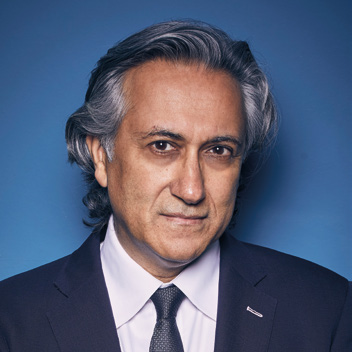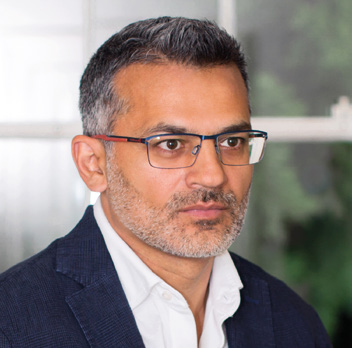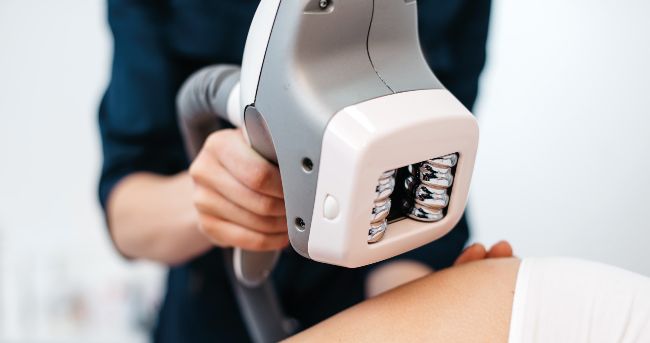BODY-CONTOURING DEVICES
Debulking the myths
We asked some of the UK’s leading authorities on body shaping which treatments they rate and whether or not these devices are truly effective at getting rid of fat

Dr Tracy Mountford

Dr Aamer Khan

Dr Preema Vig

Dr Ravi Jain
Body contouring using nonsurgical devices with minimal downtime has hugely increased in popularity recently and, with 60% of the population gaining weight during the pandemic and related lockdown, demand for in-clinic treatments that target fat looks set to continue to rise.
At our virtual conference in November we held a roundtable discussion with Dr Tracy Mountford from The Cosmetic Skin Clinic; Dr Ravi Jain from Riverbanks Wellness; Dr Preema Vig from Dr Preema London and Dr Aamer Khan of Harley Street Skin Clinic to find out which technologies and devices are most effective and what factors play a role in achieving impressive results.
AM: What treatments do you currently use in clinic for body sculpting and what has your experience been with other devices in the past?
Dr Tracy Mountford: We introduced CoolSculpting about seven years ago. In the last year we have introduced BTL Emsculpt and I think that the two combined can give really nice results in the ideal candidate.
Dr Preema Vig:
I got my [first] CoolSculpting machine back in 2014 and my second in 2019 which has been brilliant for “dual-sculpting”. I also have Emsculpt and got my device two years ago, which has been working amazingly with CoolSculpting. In clinic we also have Cutera truSculpt Flex; Unison, the BTL device for cellulite, and Venus Legacy, which targets more of the smaller cellulite deposits.
Dr Aamer Khan:
Historically we have always used radiofrequency (RF). The earlier devices were really good for skin tightening, and that remains the case, but with bi-polar we were able to get a little bit deeper and target the subcutaneous layers of fat. More recently, we are using the ONDA by Deka. This is a really interesting technology which targets different tissues in different ways. A single treatment can reduce the circumference of the abdomen by 4cm and we see this on a repeated basis.
Dr Ravi Jain: We have tried various RF devices and we entered the cryo market about seven years ago – we used CoolTech at first. Back then there was one paddle size and it did a really good job for us. Then I invested in the CoolSculpting machine. The different applicators there were with the system and the various indications made it really attractive. With the right experience, you can get the most outstanding results. My bodycontouring practice was traditionally VASER Liposuction, but then I had a patient come to see me who had this indentation above her umbilicus. I asked if she had had some lipo before and she said, “No, I had fat freezing”. I thought, “Oh my God, something actually worked non-surgically”. With all the devices I had before then, nothing created significant change – patients were generally dissatisfied. It wasn’t until I found cryo that I found the first form of non-surgical treatment that actually made a significant, noticeable change in people’s contours and shapes. For me, cryo is the gold standard for non-surgical body contouring. The RF system we have is BTL Exilis, which we generally use for people who want more skin tightening and smoothing, but our workhorses are CoolSculpting and VASER.

AM: How do you approach patient selection when it comes to body contouring?
Dr Preema Vig: It is such an individual caseby-case thing. We have to find out from the patient first of all what they want; what they are trying to achieve and also financially, what they can afford. It is very much a case of working together with the patient. When they want transformational results it’s about educating them that it is not just going to be two cycles on the abdomen and that’s going to fix everything. Before and after pictures are so important as well.
Dr Aamer Khan: It all starts with the usual consultation and listening to the patient. They will tell you not only what they would like to achieve and what bothers them but also how they got to that point. They didn’t wake up like that that morning and then decide to call you. There has been a multi-factorial process which includes physical aspects, physiological aspects, lifestyle [and] genetics. Then there’s a psychological and a cognitive point at which they decide to come and see a practitioner. They may have researched things, they may have been elsewhere; they may have ideas of what might be able to help them. By having that discussion with them and repeating their concerns back to them – which starts to build trust and empathy – you can then start to talk about what can help.
AM: How do you manage expectations?
Dr Tracy Mountford: Most important is to understand that these things have limitations; they are amazing, but they have limitations. You can think you have the best tech in your hands and you can still talk aspirationally, show before-and-afters, and be positive about the treatment but also have complete integrity and clarity and manage expectations. That I cannot stress enough – it is very important. You set yourself up for catastrophic failure if you underestimate a treatment that’s necessary for a patient or if you over-sell. You need a really strategic plan that looks at doing something in certain areas first, assessing the results, proving that it works for that patient; showing that evidence with photographs and then moving on to other areas should the patient want to do so.
Dr Aamer Khan: Taking a proper history is really key in dealing with any patient and their expectations. We have got to be really meticulous about how we approach our patients and how we consult them. Go through any pre-existing medical conditions at the beginning, because we are going to get better results if we give them medical advice, if we tell them to go to their GP and look at these things, or even do the tests ourselves to exclude particular medical conditions as part of the service we provide.
We can’t make guarantees. We have to discuss beforehand why things might not work; why a particular treatment may not achieve the results that the patient wants and then within that discussion talk about, “OK, if that doesn’t happen what are we going to do about it?” This means that if it doesn’t work, the patient is not going to be left floundering about whether to come back to you or approach you because you told them from the start that there are other options if it doesn’t work. I think you can engage your patients much better, have fewer complaints and fewer dissatisfied patients that way.
“We can’t make guarantees. We have to discuss beforehand why a treatment might not work”
– Dr Aamer Khan
AM: What are the major causes of dissatisfaction with treatment?
Dr Ravi Jain: There are three considerations: the device, the patient and the practitioner. Is the device functioning properly? Has there been a tech failure or have you used the device inappropriately? Has the patient been compliant? What has their lifestyle been? Have you or your team oversold a treatment or oversold expectations? Have you missed anything on the history taking?
You should be able to identify those patients who are unlikely to stick to the programme from your history taking. The first thing I generally do is ask patients what they had for breakfast. We’ve all seen the patient who claims to just eat one apple a day and yet they are 20 stone – it’s clearly not true. On the other side of the coin, I’ve also had patients who say they had cake for breakfast. These are the patients who have got to modify their lifestyle before they embark on a treatment plan, and perhaps they need a dietician’s advice first. Or maybe if they’re struggling and have been through all of that they may need some bariatric treatment. I tend to refer to specialists who offer those services when the patient really has problems with controlling their dietary intake.
AM: With so many different devices on the market, how do you choose which to buy for your clinic?
Dr Tracy Mountford: Look at what colleagues are using; what successes and failures have they had? Look at what’s got the profile in the market. I never was one of the early adopters of anything; I always sat back and waited and watched to see what disasters might befall certain treatments before I invested in them myself. There is a benefit to being first from a commercial and marketing point of view but there is also a big downside. I always looked to see what colleagues were doing. I would call a colleague and say, “What do you think? Should I buy this machine? What issues have you had with it?”
Dr Ravi Jain: For many people, investing in a bit of kit is probably the biggest investment they make, other than their car or their house. Moving from injectables to devices is a significant investment and this is where the companies that do this side of things well shine. It’s about partnership. What support is the company going to provide you? What training? How are they going to help you build your experience and ultimately, your business? You have to put a business plan down for this – really look at this as a significant investment. Know your market and select the device and a reputable company appropriate to that. If your clinic targets the lower end of the market, there is no point offering the top end price of a system.
Just don’t get desperate. What you find is that many people spend between £30,000 to £100,000 and then think, “I’ve got to get my money back” and fall into the trap of being desperate.
Dr Aamer Khan: It is tempting to jump in at the deep end but my advice from my own experience would be build your business first and then start looking at devices. I didn’t do it that way. I bought about £240,000 worth of lasers and then I was sat there saying, “Well, come on then” because people weren’t coming in.
That was a long time ago but we have to learn from these things. If we can share these sorts of gems I think it will make life easier for newer practitioners.